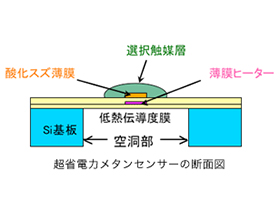Measurement
Methane Sensor Technology Enabling Battery-driven Gas Alarms
Overview
Osaka Gas has developed an extremely low-power methane sensor consuming power about 1/2000 compared with previous models.
Background
Increasing the penetration rate of gas alarms is desirable for advanced safety and security for city gas consumers. One adverse factor in increasing the penetration rate is that conventional gas alarms require AC mains power, leading to the issue of installation constraints. Accordingly, to remove the installation constraints, there has been a demand for a battery-driven gas alarm, free of the need for power supply wiring.
However, the main component of city gas is methane; to detect it, it is necessary to heat the sensor (tin oxide) to approximately 400℃. In addition, the expiration period of gas alarms is five years. Enabling a gas alarm to be driven by a battery for such a long period has been regarded as a dream technology. Osaka Gas has developed an ultra-low power methane sensor.
Features
The newly developed methane sensor features a nano-columnar thin tin oxide film (photo), which has a special fine structure of nanometer scale. The clearance (a few nanometers) between columns allows methane molecules to pass deep through the columns, thereby imparting a high sensitivity for methane.
Moreover, a selective catalyst layer allows methane alone to permeate them and burns and removes alcohol and other components. This selective catalyst layer is applied on the thin tin oxide film to detect only methane and suppress false alarms. Furthermore, the sensor uses microelectromechanical systems (MEMS) technology to achieve localized heating by a thin-film heater and intermittent drive (heating only at the moment of detection and resting during the rest of the time) owing to improved heating response. Thus, the sensor consumes only about 1/2000 the power consumed by conventional sensors. At this level of power dissipation, the gas alarm can be driven by a battery for five years.
The world’s first battery-driven gas alarm equipped with this sensor (three-year life model) was commercialized in 2015.

Future Plans
We will use the knowledge acquired through the development of the methane sensor to explore applications other than gas alarms.
Related contents
TAG SEARCH
- Evolving residential gas appliances
- Evolving residential gas appliances Water heaters, space heaters, dryers Cooking appliances Smart Equipment Fuel Cell systems
- Evolving commercial and industrial gas appliances
- Evolving commercial and industrial gas appliances Cogeneration (CHP) units Air conditioning systems, kitchen appliances Bio, water treatment Industrial furnaces, burners Energy management, IoT
- Enhancing the safety and economic efficiency of LNG regasification
- Enhancing the safety and economic efficiency of LNG regasification Utilization of cold energy Plant materials Power generation technology
- Developing next-generation businesses through enterprising initiatives
- Developing next-generation businesses through enterprising initiatives Materials development Measurement Simulation, data analysis Food science Material evaluation
- Contributing to conserving the environment and achieving a carbon neutral society
- Contributing to conserving the environment and achieving a carbon neutral society Methanation Hydrogen, ammonia Biogas Energy management Renewable Energy
- Technologies of Group companies
- KRI, Inc. Osaka Gas Chemicals Group OGIS-RI Group

